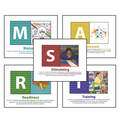Research & Resources
s.M.A.R.T. Works!
Getting children ready for school involves more than rehearsing specific behaviors and skills – brain development and stimulation are important tools in getting children prepared to learn, and once in school, continuing to support learning.
When using nationally normed measures on students across the state and nation, the results have shown that students who participate in S.M.A.R.T. outperform those who do not participate in S.M.A.R.T. S.M.A.R.T. addresses an underlying cause of learning deficits rather than addressing a specific learning deficit. The following research is a reinforcement of the importance of brain-related learning and the need to integrate brain stimulation into the normal educational regimen.
A teacher training program at heart
Teachers have reported how their S.M.A.R.T. training, classroom experiences, and the ongoing mentoring they received, got them to re-examine their teaching approaches, gave them a better perspective on the relationship between brain development and early childhood education, and alerted them to important changes in children’s learning, behaviors, and school readiness.
When using nationally normed measures on students across the state and nation, the results have shown that students who participate in S.M.A.R.T. outperform those who do not participate in S.M.A.R.T. S.M.A.R.T. addresses an underlying cause of learning deficits rather than addressing a specific learning deficit. The following research is a reinforcement of the importance of brain-related learning and the need to integrate brain stimulation into the normal educational regimen.
A teacher training program at heart
Teachers have reported how their S.M.A.R.T. training, classroom experiences, and the ongoing mentoring they received, got them to re-examine their teaching approaches, gave them a better perspective on the relationship between brain development and early childhood education, and alerted them to important changes in children’s learning, behaviors, and school readiness.
A Summary of
our Findings
Since the early 1990s, A Chance To Grow (ACTG) has completed over 30 assessments of the impacts of its brain-centered interventions on learning readiness and early literacy skills. In order to document these studies and to summarize them in one place, ACTG contracted with Gary J. Miller, Ph.D., to review each of these evaluations and to provide a comprehensive report of these results. This is a brief summary of the report. Click here to download the comprehensive report.

